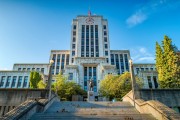You've heard talk of the "green economy," but what does it really mean? Sometimes it's hard to put your finger on it. That's why we're releasing a series of fact sheets that help to paint a picture of what the green economy looks like for British Columbians.
The first fact sheet, The Business of Climate Change, looks at how businesses are capitalizing on the challenges and opportunities presented by climate change. It profiles six B.C. companies that are facing the climate change challenge head-on — either by reducing their own emissions or providing goods and services that help others to reduce emissions. When you add these individual success stories together you start to get a picture of what the green economy could look like.
"A key driver in our decision-making is the knowledge that the price of carbon will be increasing in the future. We want to be well-positioned to compete in an energy and carbon-constrained world."
— Esther Speck, Director of Sustainability, Mountain Equipment Co-op
Mountain Equipment Co-op, for example, has reduced its transportation emissions by 30% by transporting its goods primarily by train, rather than truck — saving money along the way.
Azure Dynamics, on the other hand, has a whole business founded on reducing emissions. The U.S.-based company with an office in Burnaby has developed electric and hybrid electric drive technology for commercial vehicles, including delivery trucks, school buses and shuttles. Azure estimates that use of its technology has already resulted in a reduction of more than 32,000 tonnes of greenhouse gas emissions.
While we've traditionally focused on higher-level policy discussion on topics such as the carbon tax, it's important to talk about how it translates on the ground. In the case of businesses, the carbon tax helps ensure reducing energy use is good for the bottom line, as well as the planet, as reported in the Vancouver Sun.
What does the green economy look like at home? For some families, it might mean driving less and installing a solar water heater, while others may start by investing in affordable options such as weather stripping and compact fluorescent light bulbs.
 In our fact sheet on families, Walking the Green Talk, we profile four hypothetical households in B.C. and look at how these types of changes, and others, can help them get ahead in the green economy. But we also look at how we need to support lower income families to ensure that they, too, can take advantage of the green economy. The bottom line is all of these actions help tackle climate change and save families money, both on energy costs and on the carbon tax.
In our fact sheet on families, Walking the Green Talk, we profile four hypothetical households in B.C. and look at how these types of changes, and others, can help them get ahead in the green economy. But we also look at how we need to support lower income families to ensure that they, too, can take advantage of the green economy. The bottom line is all of these actions help tackle climate change and save families money, both on energy costs and on the carbon tax.
In our third fact sheet, Putting a Price on Climate Pollution, we look at the principles behind a fair and effective carbon tax. While the other two look at life on the ground, this one looks at a key policy needed to get us there. Read this one if you'd like to better understand the rationale behind putting a price on climate pollution.
Together these three fact sheets help us to imagine what life will look like in a green economy. Hope you enjoy the series. Please comment below with your feedback.






